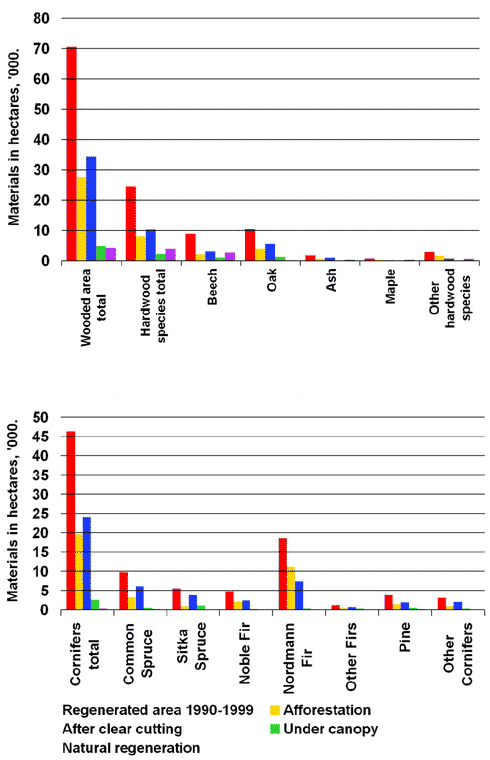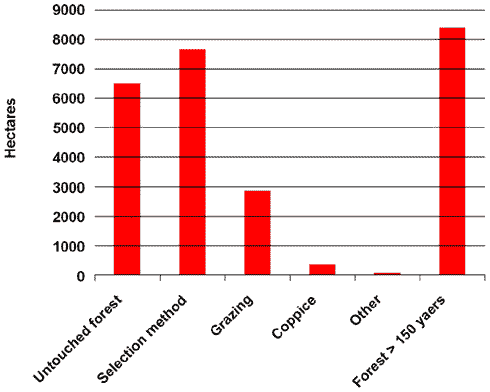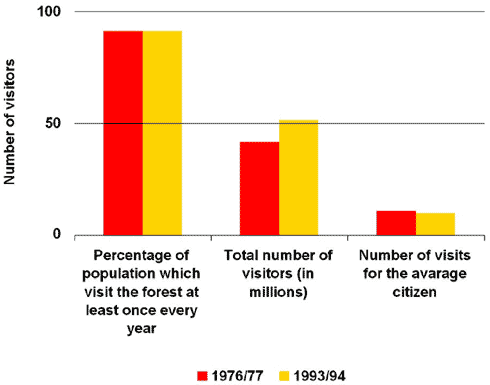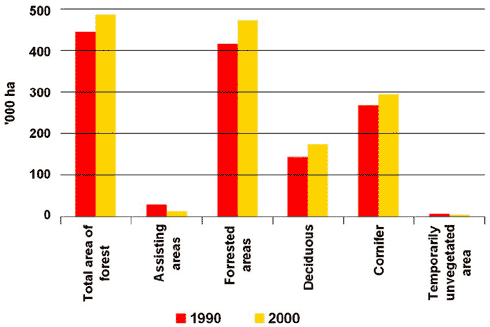Indicator Report
10. Forestry
Objectives
Forests and woodland areas should be used and managed in such a way as to allow them to play a part in fulfilling Denmark's nature, environmental, financial, and social needs, now and in the future. We should bolster the role of forests as one of society's welfare assets. Forests should provide opportunities for outdoor activities protect biodiversity and contribute to a varying landscape. Forests should produce wood products and help protect the environment, including protection of the groundwater and sequestration of CO2.
Developments - a summary
The Danish forest areas are steadily growing larger, and during the period 1990 to 2000, the increase was relatively larger for deciduous woods than for conifers. Even though the forest area keeps growing larger, the present rate of increase is not sufficient to reach the objective concerning an increase in the forested area of Denmark so that forest landscapes cover 20-25 per cent of the Danish landscape in the course of one tree generation (80-100 years).
Parts of the public as well as the private forestry sector are currently working towards forestry according to near-nature principles. There is a particular wish to increase the area of deciduous forest. During the period 1990 to 1999, a total of approximately 70,000 hectares of forest were regenerated in Denmark. Of these, deciduous trees were used on almost 25,000 hectares, while conifers cover approximately 45,000 hectares. As deciduous trees account for less than half of the existing forest area, this entails an increase in the spread of deciduous trees.
Most areas in forests with special nature considerations are untouched forests or cut in accordance with the selection method, while grazing forest and coppice forest account for smaller areas. Woodlands aged 150 years or more account for approximately 8,400 hectares. No special requirements concerning forestry methods apply here, but greater biodiversity is likely in these areas. The objective in the Natural Forest Strategy stipulating that in 2000, at least 5,000 hectares should be designated as untouched forest or forest cut according to the selection method has been reached. This also applies to the objective stipulating that grazing forest, coppice forest, and other forest types should account for at least 4,000 hectares in 2000.
The number of visits made to Danish forests has risen from approximately 40 million a year in 1976/77 to approximately 50 million a year in 1993/94. This development is caused by an increase in the average number of visits to forests. The percentage of the population who visit the forests at least once a year remains unchanged at 91 per cent.
Perspectives for development of indicators
The indicators are based on the guidelines on sustainable forestry agreed upon by a broadly based working group in May 2001. The guidelines are partly based on near to nature forest management as a means for improving forest sustainability. The indicators are also based on the common European criteria and indicators for sustainable forestry which broadly define the significance of sustainable forestry. Data capable of elucidating the various aspects of nearnatural forestry will become available when the new National Forest Inventory (NFI) is implemented in the years to come.
An indicator must be developed for the percentage of imported wood which has been environmentally certified in order to monitor consumption of imported wood and wooden products which have been legally forested and come from forests which are cultivated in a sustainable manner.

Indicator 10.1:
Forest regeneration and establishment methods. These include the proportion of
regeneration material consisting of native tree species.
Source: The Danish F orest and Nature Agency, the Danish F orest and Landscape Research
Institute, and Statistics Denmark.
This indicator elucidates developments pertaining to near to nature and environmentally friendly forest management. The figure shows the total regeneration of forest during the period 1990 to 1999, by species and regeneration method. The regeneration species have been analysed by two overall groups (deciduous trees and conifers) as well as by individual species within the two groups. The total regeneration area is divided into four regeneration methods: afforestation, after clear-cutting, under canopy, and natural regeneration. The method used for regeneration is a more accurate indicator for near- to nature forest management than the choice of species, as native species are not a precondition for near to nature forest management.
During the period 1990 to 1999, a total of approximately 70,000 hectares of forest were regenerated in Denmark. Of these, deciduous trees were used on almost 25,000 hectares, while conifers cover approximately 45,000 hectares. Beech and oak dominate the group of deciduous trees. Among conifers, Nordmann fir and noble fir are widely used. These species are typically grown for Christmas trees and decorative greens. Afforestation and regeneration after clear-cutting are the dominant methods of regeneration. When discounting establishment of Nordmann fir and noble fir, which is often carried out on farmland, deciduous woods account for approximately half the regenerated area. As deciduous trees account for less than half of the existing forest area, this entails an increase in the spread of deciduous trees.
Parts of the public as well as the private forestry sector are currently working towards forestry according to near-natural principles. This will probably lead to ever-more frequent use of the regeneration methods "under canopy" and "natural regeneration" in the years to come. There is a political desire to increase the area of deciduous forest in Denmark. This is evident in the form of subsidies for planting of deciduous trees in private forests and in the species policy applied to the areas owned by the Forest and Nature Agency.

Indicator 10.2:
Forests with special nature considerations
Source: The Danish Forest and Nature Agency, the Danish Forest and Landscape Research
Institute, and Statistics Denmark.
This indicator elucidates developments pertaining to nearnatural and environmentally friendly forestry. The figure shows the percentage of the Danish forest area reserved for a silvicultural system which pays special attention to biodiversity (untouched forest, selection-method forestry, grazing forest, coppice forest, and others). In addition to this, the figure also shows the amount of forest older than 150 years.
Most areas in forests with special nature considerations are untouched forest or cut in accordance with the selection method, while grazing forest and coppice forest account for smaller areas. Woodlands aged 150 years or more account for approximately 8,400 hectares. No special requirements concerning forestry method apply here, but greater biodiversity is likely in these areas.
The 1994 Natural Forest Strategy stipulated that in 2000, at least 5,000 hectares should be designated as untouched forest, whereas forest cut according to the selection method, grazing forest, coppice forest, and other forest types should account for at least 4,000 hectares in 2000. When we compare these figures with the graph, we see that the target has been met.

Indicator 10.3:
Number of visitors to forests
Source: The Danish Forest and Landscape Research Institute,
This indicator elucidates the trends regarding recreational use of Danish forests. The figure shows the number of visitors in Danish forests in 1976/77 and 1993/94. The data used for the survey have been collected in the form of representative interviews conducted over the course of one year. Both studies involved interviews with approximately 3,000 people.
Based on these interviews, the number of visits made to Danish forests has been estimated at approximately 40 million a year in 1976/77 and approximately 50 million a year in 1993/94. This development is caused by an increase in the average number of visits to forests (more people making relatively many visits). At the same time, we see that the average citizen now makes 10 visits a year rather than 11. This is due to the fact that a relatively larger percentage of the population visits the forest a few times. The percentage of the population who visit the forests at least once a year remains unchanged at 91 per cent.
Increased recreational use of forests is assumed to promote welfare and health, which makes it a positive development as regards use of Danish forests.

Indicator 10.4:
Total forest area
Source: The Danish F orest and Nature Agency, the Danish F orest and Landscape Research
Institute, and Statistics Denmark.
This indicator illustrates developments regarding the total forest area in Denmark during the period 1990 to 2000. In addition to this, it illustrates developments for assisting areas, forested areas, deciduous trees, conifers, and temporarily non-vegetated areas.
The Danish forest area grows ever larger. During the period 1990 to 2000, stocks of deciduous trees and conifers both grew. As will be clear from the figures, the increase for deciduous trees is relatively larger than for conifers. The extent of assistance areas has fallen, which is primarily the result of a new calculation method.
In 1989, the Danish Parliament decided that the Danish forest area must be doubled during a period of 80 to 100 years. As will be evident from the above, the Danish forest area is constantly growing. The rate of expansion is not, however, sufficiently high to successfully meet the objective of doubling the forest area within 80 to 100 years. As can be observed from the figures, the areas of deciduous woodland and conifer forest are both increasing, with the area of deciduous trees increasing relatively more than coniferous woodland.